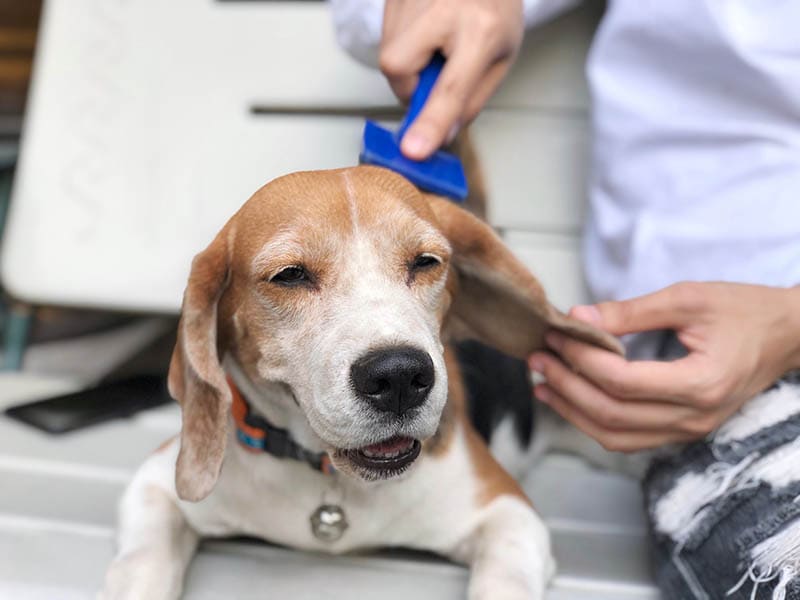🐕 Are Beagles Hypoallergenic? No, here's why❌ Quick Answer: No, Beagles are NOT considered hypoallergenic! Beagles have a moderate to high shedding level and produce typical amounts of dander and allergens. Their short, dense double coat sheds year-round, with heavier seasonal shedding periods. While they're wonderful family companions, Beagles are not recommended for people with dog allergies.

🌿 Beagles are charming companions, but their shedding coat produces allergens 🐾 Beagle Quick FactsShedding Level: Moderate to High
Hypoallergenic: No ❌
Coat Type: Short Double Coat
Grooming Needs: Moderate
Drooling Level: Low to Moderate
Dander Production: Moderate
Lifespan: 12-15 years
Weight: 20-30 lbs (9-13.5 kg)
Height: 13-15 in (33-38 cm)
🔬 What Makes a Dog Breed Hypoallergenic?Before we dive into why Beagles aren't hypoallergenic, let's understand what creates an allergy-friendly dog breed. No dog is 100% hypoallergenic, but some breeds produce significantly fewer allergens than others. 
🐶 Adorable Beagle puppies bring joy, but they also bring dander Dog allergies are triggered by proteins found in: 🔹 Dander: Tiny flakes of dead skin that all dogs shed 🔹 Saliva: When dogs lick themselves or people 🔹 Urine: Contains allergenic proteins 🔹 Fur: Acts as a carrier for dander and dried saliva Truly hypoallergenic breeds typically share these characteristics: they have single-layer coats instead of double coats, shed minimally or not at all, produce less dander, and have hair that grows continuously rather than shedding in cycles. Beagles, unfortunately, possess none of these traits. ↑ Back to Menu❌ Why Beagles Aren't HypoallergenicLet's be straightforward: Beagles are among the breeds that produce more allergens, not fewer. Here's why this beloved breed doesn't make the hypoallergenic list. 
🍂 That beautiful face comes with a coat that sheds considerably 🔸 Double-Coat StructureBeagles have a dense double coat consisting of a soft undercoat and a harder outer coat. This design, perfect for hunting in various weather conditions, means twice the shedding and twice the dander. The undercoat sheds heavily, especially during seasonal changes in spring and fall, releasing substantial amounts of hair and dander into your home. 🔸 Year-Round SheddingUnlike some breeds that shed seasonally, Beagles shed throughout the entire year. You'll notice their short hairs on furniture, clothing, and floors daily. These hairs carry dander and dried saliva, spreading allergens continuously around your living space. 
✂️ Regular brushing is essential but releases even more dander into the air 🔸 Moderate Dander ProductionBeagles produce typical amounts of dander for their size. Their skin naturally regenerates, and those microscopic skin flakes become airborne easily due to the dog's active nature. Beagles are energetic, playful dogs who love to run and shake, dispersing dander throughout your home. 🔸 Active LickersBeagles are affectionate dogs who love to give kisses and groom themselves regularly. This licking behavior spreads allergenic proteins from their saliva onto their fur, which then becomes airborne when they shed or shake their coat. ⚠️ Important Note for Allergy Sufferers: If you have moderate to severe dog allergies, a Beagle is likely to trigger symptoms. While they're wonderful dogs in many ways, their allergen production makes them unsuitable for most people with allergies. 🤧 Can People with Allergies Live with Beagles?This is a common question, and the honest answer is: it depends on the severity of your allergies. Here's what you need to know. 
🛋️ That cozy couch time means dander on your furniture 🔹 Mild AllergiesIf you have very mild dog allergies, you might manage living with a Beagle through diligent cleaning, air purification, and medication. However, be prepared for ongoing symptoms and understand that allergies can worsen over time with constant exposure. 🔹 Moderate to Severe AllergiesFor anyone with moderate to severe allergies, getting a Beagle is not recommended. The constant shedding and dander production will likely make your home uncomfortable, and no amount of cleaning or medication may provide adequate relief. Your health and quality of life must come first. 
🍽️ Even mealtime activities can spread allergens through the house 🔹 What You Can ExpectCommon symptoms when living with a Beagle include: • Sneezing and runny nose, especially after petting or playing • Itchy, watery eyes that worsen in rooms where the dog spends time • Nasal congestion that may be worse in the morning • Skin reactions if the dog licks you or you touch your face after petting • Breathing difficulties for those with asthma The good news about Beagles is that they have many wonderful qualities: they're friendly, great with children, relatively small, excellent family dogs, and have minimal drooling compared to some breeds. However, these positive traits don't change their allergen production level. ↑ Back to Menu🔍 Looking for a Dog That Won't Trigger Allergies?If you love the Beagle's friendly personality but need a more allergy-friendly option, our breed selector tool can help you discover compatible breeds that match your lifestyle while minimizing allergen exposure. Get personalized breed recommendations based on your allergy sensitivity and lifestyle in under 2 minutes! 🔄 Hypoallergenic Alternatives to BeaglesIf you're drawn to Beagles but need an allergy-friendly breed, consider these alternatives. While no dog is completely hypoallergenic, these breeds produce significantly fewer allergens. 
🎾 If you love active, playful dogs, several hypoallergenic breeds share this energy
💡 Why These Alternatives Work: These breeds share qualities that Beagle lovers appreciate, such as friendly temperaments, good family compatibility, and energetic personalities, but with significantly less shedding and dander production. The Basenji is particularly interesting as it's similar in size to a Beagle and has a short coat, but with minimal shedding. 💡 Tips for Allergy Sufferers Who Already Own BeaglesPerhaps you're reading this after already bringing a Beagle into your home, or you've fallen in love with one despite your allergies. Here are practical strategies that can help reduce allergen exposure, though they won't eliminate the problem entirely. 
❄️ Outdoor activities help keep some allergens outside your home 🏠 Home Environment ManagementEstablish dog-free zones: Keep your bedroom completely off-limits to your Beagle. This gives you at least eight hours of reduced allergen exposure each night, which can significantly impact your overall symptom levels. Invest in quality air purifiers: Place HEPA air purifiers in rooms where you spend the most time. These can capture dander particles and reduce airborne allergens by up to 50%. Replace carpets with hard flooring: Carpets trap dander and hair, making them allergen reservoirs. Hard floors are much easier to clean and don't harbor allergens the way carpeting does. Use washable furniture covers: Cover sofas and chairs with washable slipcovers and wash them weekly in hot water to remove accumulated dander. 
🍁 Regular outdoor walks are beneficial for both you and your Beagle ✂️ Grooming StrategiesBrush outdoors daily: Have someone without allergies brush your Beagle outside every day. This removes loose hair and dander before it spreads through your home. During heavy shedding seasons, brush twice daily. Weekly baths: Bathe your Beagle weekly using a gentle dog shampoo. This removes dander from their coat and can reduce allergen levels temporarily. Always have someone else handle bath time to minimize your exposure. Consider professional grooming: Taking your Beagle to a groomer every 4-6 weeks means the heavy brushing and bathing happens away from your home environment. 
🌳 Creating comfortable outdoor spaces gives your Beagle enjoyment while reducing indoor allergens 🧼 Cleaning RoutinesVacuum with HEPA filters: Vacuum all floors and furniture at least three times per week using a vacuum with a HEPA filter. Regular vacuums can actually blow allergens back into the air. Damp-mop hard floors: After vacuuming, damp-mop to capture any remaining dander particles that vacuuming missed. Wash dog bedding weekly: Your Beagle's bed, blankets, and toys should be washed in hot water weekly to remove accumulated allergens. 💊 Medical ManagementWork with an allergist: A board-certified allergist can prescribe medications and possibly immunotherapy that may help manage your symptoms. Don't try to handle moderate to severe allergies on your own. Take antihistamines proactively: Rather than waiting for symptoms to appear, take your allergy medication daily as prescribed by your doctor. ⚠️ Reality Check: Even with all these measures, you may still experience allergy symptoms with a Beagle in your home. These strategies reduce but cannot eliminate allergen exposure. Be honest with yourself about your quality of life and whether this is sustainable long-term. 🧪 Testing Before Adopting a BeagleIf you have allergies but are considering a Beagle, proper testing is absolutely essential. Don't make assumptions—test your actual allergic response to the breed. Here's how to do it right. 
🪟 Spend quality time with Beagles before making a commitment 🔹 Visit Multiple TimesOne visit isn't enough to gauge your allergic response. Spend time with Beagles on at least 3-5 separate occasions, ideally in different environments. Visit breeders, friends with Beagles, or volunteer at a shelter that has Beagles. 🔹 Spend Extended Time TogetherBrief encounters won't reveal the full picture. Try to spend at least 2-3 hours with a Beagle in an enclosed space. Pet them, play with them, let them lick you (if they want to), and sit on furniture they use regularly. This simulates actual living conditions. 🔹 Pay Attention to Delayed ReactionsSome allergic reactions don't appear immediately. Note any symptoms that develop within 24 hours after your visit. Keep a journal of your symptoms: when they started, how severe they were, and how long they lasted. 🔸 Foster First if Possible: Some rescue organizations allow trial periods or fostering. This is the gold standard for testing compatibility. Living with a Beagle for 2-4 weeks will definitively show whether you can manage the allergen exposure. This protects both you and the dog from a failed adoption. 🔹 Get Professional Allergy TestingVisit an allergist for proper testing before committing to a Beagle. They can determine exactly which allergens trigger your reactions and assess the severity. This medical insight is invaluable for making an informed decision. 🔹 Be Honest About What You DiscoverThis is perhaps the most important step. If you experience significant symptoms during testing, please believe what your body is telling you. It's heartbreaking to return a dog after adoption because allergies made the situation untenable. Making the right decision upfront protects both your health and prevents emotional trauma for a dog who would need to be rehomed. ↑ Back to Menu❓ Frequently Asked QuestionsSome Beagle mixes with hypoallergenic breeds (like Poodles, creating "Poogles") may produce fewer allergens than purebred Beagles. However, there's no guarantee a mixed breed will inherit the hypoallergenic parent's low-shedding coat. Each puppy is different, and some Beagle mixes shed just as much as purebred Beagles. If you're considering a Beagle mix, spend extensive time with the specific dog you're thinking of adopting, not just the breed in general. 🐾 This is a common misconception. Puppies actually may cause similar or even worse allergic reactions because they tend to be more mouthy, lick more frequently, and have active oil glands as their skin develops. Additionally, allergic reactions often worsen with prolonged exposure, so even if symptoms seem mild with a puppy, they may intensify as the dog grows and you're exposed to allergens over months and years. 🐶 No, bathing cannot make a Beagle hypoallergenic. While weekly baths can temporarily reduce the amount of dander and allergens on your Beagle's coat, they will never eliminate allergen production entirely. The dog will continue to shed, produce dander, and create allergens through saliva. Bathing is helpful for managing allergen levels but won't transform a high-allergen breed into a low-allergen one. Think of it as a management tool, not a solution. 🛁 Beagles fall into the moderate to high allergen production category. They produce more allergens than breeds like Poodles, Bichon Frises, or Portuguese Water Dogs, but roughly similar amounts to other double-coated breeds like Labrador Retrievers or German Shepherds. Their short hair might seem less problematic than long-haired breeds, but it's actually easier for short hairs to become airborne and embed in fabrics. Among popular family dogs, Beagles are definitely on the higher end of allergen production. 📊 This requires very careful consideration. Children with mild allergies might manage with proper precautions, but those with moderate to severe allergies or asthma should not have a Beagle. Children often have closer contact with dogs than adults—sleeping near them, face-to-face play, being licked—which increases allergen exposure. Consult with your child's allergist before making this decision. It's heartbreaking to rehome a dog when a child's health is compromised. Your child's wellbeing must take priority. 👨👩👧👦 There's limited scientific evidence supporting significant differences between male and female Beagles regarding allergen production. Some studies suggest that intact (unneutered) males may produce slightly more allergens due to hormonal proteins, but the difference is minimal. Both male and female Beagles shed heavily, produce dander, and create allergens through saliva. Gender should not be a factor in your decision if you have allergies—both will likely trigger similar reactions. ♂️♀️ Honestly, there's no "good" season for allergy sufferers to adopt a Beagle because they shed year-round. However, they do have heavier shedding periods during spring and fall as they transition between winter and summer coats. If you're determined to adopt despite allergies, late spring or late fall (after the major sheds) might give you a brief adjustment period before the next heavy shedding cycle. But remember—you'll still face allergen exposure daily, regardless of season. 📅 No, air purifiers cannot eliminate all allergens, but they can significantly reduce airborne dander particles. High-quality HEPA air purifiers can remove up to 50-70% of airborne allergens, which may provide some relief. However, allergens also settle on surfaces—furniture, floors, clothing—where air purifiers can't reach them. Air purifiers are a valuable part of allergen management but should be combined with rigorous cleaning, grooming, and other strategies. They're helpful but not a complete solution. 💨 🎯 Final Thoughts: Making the Right DecisionHere's everything you need to know about Beagles and allergies, along with some important advice. Beagles are absolutely wonderful dogs—they're loyal, affectionate, great with families, excellent with children, have cheerful dispositions, and their size makes them adaptable to various living situations. Their friendly howls and boundless enthusiasm bring joy to countless homes. 💕 However, if you have dog allergies, a Beagle is objectively not the right choice. Their moderate to high shedding, continuous dander production, and double coat structure make them incompatible with allergy management. No amount of love for the breed changes this biological reality. The temptation to get a Beagle despite allergies is understandable. Perhaps you grew up with Beagles, or you've fallen in love with their floppy ears and soulful eyes. But choosing a dog that triggers your allergies leads to three possible outcomes: living in constant discomfort, spending significant money on medical interventions and cleaning products, or facing the heartbreaking decision to rehome the dog. None of these outcomes is fair to you or to the dog. The good news? Many hypoallergenic breeds offer similar qualities to Beagles—friendly temperaments, family compatibility, and energetic personalities—without the allergen load. Exploring these alternatives means you can still experience the joy of dog ownership without compromising your health. Your decision should prioritize both your wellbeing and the dog's future. A dog deserves a home where they're welcomed without reservation, and you deserve to breathe comfortably in your own space. Making the right choice upfront prevents heartbreak later. If you're set on a Beagle despite allergies, please complete thorough testing first. Spend extensive time with the breed, consult with an allergist, and be brutally honest about what you discover. Your body will tell you the truth—please listen to it. 🩺 ✨ Remember: The perfect dog for you is one that fits your health needs AND your heart. There's a breed out there that offers both—it just might not be a Beagle. And that's okay. Making a wise, informed decision means years of happy companionship ahead, whether that's with a hypoallergenic alternative or, if your allergies are truly mild, a well-managed Beagle relationship. 🏡 | ||||||||||||||||||||||||||||||||||||
|
| ||||||||||||||||||||||||||||||||||||
| Переглядів: 38 | | | ||||||||||||||||||||||||||||||||||||
| Total comments: 0 | |
